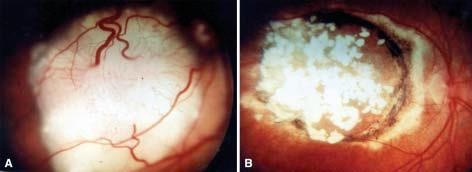Abstract
Purpose: To evaluate chemoreduction as a new method used in reducing the size of retinoblastoma to allow a more focused therapeutic measures
Patients & Methods: Nine patients with intraocular retinoblastoma (5 unilateral & 4 bilateral) were included in this study. The age of patients ranged from 13 - 32 months. They were treated with 6 cycles of chemotherapy using vincristine, etoposide, and carboplatin (VEC), followed by supplemental treatment with thermotherapy, cryotherapy, or argon laser photocoagulation. The tumor(s) response was documented with monthly follow-up eye examinations under general anesthesia and fundus photography. The follow-up period ranged from 12 - 18 months.
Results: After 6 cycles of chemoreduction (VEC), all of the 11 larger tumors (> 10 mm) showed regression in size. All vitreous and subretinal seeds showed favorable response with calcification or disappearance of most of seeds. With the addition of supplemental therapy, no recurrence of vitreous or subretinal seeds was found.
Conclusion: Chemoreduction and agjuvant therapy provide good tumor control for the intraocular retinoblastoma and its seeds. It is specially recommended for large retinoblastomas (> 10 mm in D) in an eye that would require enucleation , with no evidence of extraocular extension into the optic nerve or distant metastases.


